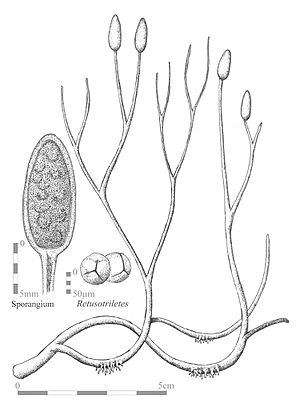Aglaophyton facts for kids
Quick facts for kids Aglaophyton |
|
|---|---|
 |
|
| Reconstruction of the sporophyte of Aglaophyton, illustrating bifurcating axes with terminal sporangia, and rhizoids. Insets show a cross-section of a sporangium and the probable spores. | |
| Scientific classification |
|
| Clade: | Polysporangiophytes |
| Genus: | †Aglaophyton D.S.Edwards 1986 |
| Species | |
|
|
| Synonyms | |
|
|
Aglaophyton is a very old plant that lived a long, long time ago. It's a fossil plant from the Devonian period, which was about 400 million years ago! Scientists have found its fossils in a special rock called the Rhynie chert in Scotland.
Only one type of Aglaophyton has been found, called Aglaophyton major. The fossils we have show only the part of the plant that makes spores, which is called the sporophyte.
How Aglaophyton is Related to Other Plants
When Aglaophyton was first discovered, people thought it was a type of vascular plant. Vascular plants are like most plants you see today. They have special tubes inside them to carry water and nutrients.
However, scientists later found that Aglaophyton was a bit different. It did have tubes for water, called vascular tissue, but the walls of these tubes were very thin. This is different from true vascular plants like Rhynia, which lived at the same time.
Because of these thin-walled tubes, Aglaophyton is seen as a special "missing link." It helps us understand how plants changed over time. It might be a step between simpler plants like Bryophytes (mosses and liverworts) and the more complex vascular plants.
In 2004, some scientists created a cladogram. This is like a family tree for living things. In this tree, Aglaophyton was placed as a "sister group" to all other vascular plants. This means it's very closely related to them, but not quite a true vascular plant itself.
Images for kids
See also
 In Spanish: Aglaophyton major para niños
In Spanish: Aglaophyton major para niños


